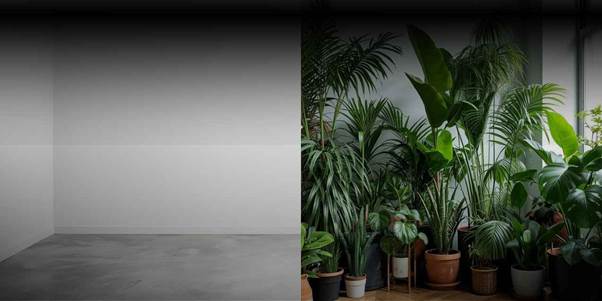Breathing clean air at home is essential for a healthy lifestyle, and indoor air purifying plants make it easy to achieve that naturally. These green companions not only filter out harmful toxins but also enhance mood, reduce stress, and add beauty to your space. From the elegant peace lily to the hardy snake plant, these natural air filters can transform your home into a calming, eco-friendly retreat.
In this article, we’ll explore the ten most effective plants that improve air quality, promote indoor wellness, and bring a refreshing green touch to your living environment.

Understanding Indoor Air Purifying Plants
Indoor air purifying plants are natural, living air filters that help remove toxins, dust, and pollutants from your home environment. These plants are not just decorative they play a vital role in maintaining healthy indoor air quality. Research by NASA first highlighted how certain houseplants can absorb common pollutants like benzene, formaldehyde, and trichloroethylene, improving overall air freshness. Since then, these plants have gained global popularity as natural solutions for cleaner indoor spaces.
Healthy air indoors is more important than ever, especially in urban areas where ventilation is often limited. Air-purifying plants bridge the gap between nature and modern living, providing both aesthetic appeal and respiratory benefits.
Why Indoor Plants Matter for Air Quality
Modern homes contain hidden pollutants from furniture, paints, and cleaning products. These compounds release harmful particles that can cause headaches, allergies, and fatigue. Indoor plants help reduce these toxins while increasing humidity and oxygen levels.
Key Benefits
• Improve oxygen flow and reduce carbon dioxide buildup
• Lower stress and anxiety levels through natural greenery
• Help maintain comfortable humidity levels in dry environments
• Boost focus, creativity, and productivity at home or work
Bringing greenery indoors can create a calming and energizing atmosphere that supports both physical and mental well-being.
Top 10 Indoor Air Purifying Plants
Here are ten of the best options to refresh your home and promote healthy air circulation:
1. Spider Plant (Chlorophytum comosum)
Perfect for beginners, the spider plant thrives in indirect sunlight and requires minimal care. It effectively removes formaldehyde and xylene, making it a great addition to bedrooms and living rooms.
2. Peace Lily (Spathiphyllum)
Known for its white blooms, this elegant plant not only adds beauty but also cleanses the air by eliminating mold spores and harmful chemicals. It thrives in low light and moderate humidity.
3. Snake Plant (Sansevieria trifasciata)
Often called “mother-in-law’s tongue,” this tough plant survives with little water and light. It filters out nitrogen oxides and benzene and continues producing oxygen even at night ideal for bedrooms.
4. Aloe Vera
Beyond its healing gel, aloe vera purifies air by removing formaldehyde and benzene, commonly found in household cleaners and paints. It also doubles as a natural skin soother.
5. Boston Fern (Nephrolepis exaltata)
A classic choice for hanging baskets, Boston fern excels at increasing humidity and removing indoor air pollutants like xylene and toluene. Regular misting keeps it lush and healthy.
6. Bamboo Palm (Chamaedorea seifrizii)
This tropical beauty adds a luxurious touch to interiors while acting as a natural humidifier. It efficiently removes airborne toxins and thrives in shaded areas.
7. Rubber Plant (Ficus elastica)
With its broad, glossy leaves, the rubber plant absorbs toxins and produces abundant oxygen. It’s also great for absorbing carbon dioxide during the day.
8. Areca Palm (Dypsis lutescens)
Popular for its graceful fronds, Areca palm is known to improve moisture levels indoors and remove airborne toxins like formaldehyde. It’s also pet-friendly and easy to maintain.
9. English Ivy (Hedera helix)
This fast-growing climber filters out mold particles and airborne fecal matter, making it especially useful for bathrooms and kitchens. It grows well in both soil and water.
10. Gerbera Daisy (Gerbera jamesonii)
Besides its colorful flowers, Gerbera daisy improves nighttime oxygen levels and removes benzene and trichloroethylene from the air.
Caring for Your Air-Purifying Plants
Even the most beneficial plants need proper care to stay effective.
Follow these tips to maintain healthy, thriving plants:
• Water moderately and avoid overwatering
• Clean leaves regularly to prevent dust buildup
• Place plants near indirect sunlight for optimal growth
• Rotate plant positions every few weeks to ensure balanced light exposure
• Use natural fertilizers to encourage strong root systems
Consistent care not only keeps your plants vibrant but also maximizes their air-cleaning potential.
Challenges and Considerations
While indoor air purifying plants are highly beneficial, there are a few challenges to consider:
• Some species may cause allergies or be toxic to pets
• Overwatering can lead to root rot and fungal growth
• Limited sunlight in small apartments may slow plant growth
• Larger plants might require repotting and extra space
Understanding each plant’s specific needs ensures a healthy balance between beauty and functionality.

The Importance of Green Living
Integrating plants into your daily environment contributes to a sustainable and eco-friendly lifestyle. Indoor greenery symbolizes a reconnection with nature, something modern life often lacks. It reduces dependence on artificial air fresheners and promotes natural well-being.
Adding just a few plants can transform your living space into a peaceful sanctuary filled with fresh air and vitality. These small steps not only improve indoor air quality but also remind us of the profound harmony between humans and nature.
Final Thoughts
Whether you’re a beginner or a plant lover, incorporating indoor air purifying plants can make your home healthier and more inviting. With the right mix of greenery like snake plants, peace lilies, and aloe vera you can enjoy cleaner air, lower stress, and a touch of natural beauty every day. Start small, care consistently, and watch as your indoor environment transforms into a refreshing, life-enhancing oasis.
Conclusion
Incorporating indoor air purifying plants into your home is a simple yet powerful way to enhance health, comfort, and beauty. These natural air filters not only cleanse the atmosphere but also uplift your mood and create a soothing environment. From peace lilies to snake plants, each species contributes uniquely to cleaner air and improved well-being. Embracing these green companions supports a more sustainable lifestyle. Explore more about indoor air purifying plants and discover how small changes in your surroundings can lead to a fresher, healthier living space.